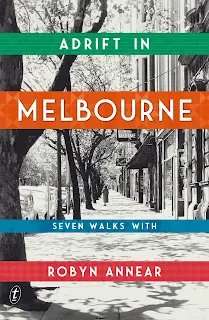I'm a proud resident of Melbourne and live close to the CBD where I've witnessed extraordinary changes to the city over the years. I've seen the tallest building in Melbourne erected from a dusty carpark, and then seen the title of Melbourne's tallest building Eureka eclipsed. I've witnessed the opening of Federation Square, the beginning of the metro tunnel, the establishment of new galleries and more. The city of Melbourne is continually evolving and I'm certain we're going to continue seeing further change and development in the future.
Having enjoyed Old Vintage Melbourne by Chris Macheras so much last year, the chance to explore the city further with Robyn Annear was too tempting an opportunity to pass up.
In Adrift in Melbourne - Seven Walks with Robyn Annear, the author guides us through the city of Melbourne and the reader can recreate the tours on the ground or experience them via Google Maps or from the comfort of home. I chose the armchair traveller option but had to keep my device handy as I was constantly looking up images of buildings still present and those lost to the bulldozers of time and progress.
Annear's sense of humour and personal touch accompanies us on every tour and while largely focussed on the history of buildings and locations, here's a funny story from the intersection of Franklin and William streets:
"During a lull in traffic one weekday morning in 1952, a large grey shag landed in the middle of this intersection and disgorged two live fish. A city-bound cyclist, without even dismounting, scooped up both fish and kept riding." Page 255Can you imagine your astonishment on seeing this today? I imagine it would have been exactly the same for those pedestrians 70 years ago. What a hoot!
Reading Adrift in Melbourne, I was continually learning and marvelling, did you know:
"By the 1930s, Flinders Street Station was the busiest in the world, swallowing and disgorging more than twice as many passengers weekly as Grand Central station in New York." Page 40I've just started researching Docklands and re-acquainting myself with the well established suburb it is today, and laughed when I read this:
"Take a tram west... and you'll arrive at the intersection of Collins and Bourke streets. Talk about a mind-fuck. Welcome to Docklands." Page 74Indeed! The meeting of two parallel streets is a complete mind-fuck and Annear couldn't have said it better.
Phrases and sayings snuck into the book occasionally and they were always entertaining. How's this one:
'Latrobe had a smile that might ripen a banana'. Meaning, presumably, that it was radiant like the tropical sun. Page 159-160What a classic description! I had no idea that 448 Queen Street was once home to Holt's Melbourne Matrimonial Agency, or that thousands of residents would mill around the GPO when a 'flag raised over the clock tower signalled the arrival of a mail ship from England.' Anyone wanting to collect or post a letter had to queue at the GPO for hours, with observations of staff being knee deep in mail. I can't imagine it, can you?
In 1850:
"Something like two hundred thousand letters and three hundred thousand newspapers passed through the Melbourne post office, and within three years, those numbers would increase ten-fold." Page 192The process for the cleaning of straw bonnets was absolutely remarkable, and I was exhausted just reading about the detailed process that took days to complete on page 146. I just dearly wished the book included some photographs of the sites mentioned. I constantly had to set the book aside and dive into Google in order to bring up images of the buildings and sites mentioned.
The author's love of history is evident and even her casual reference to the veranda blitz of 1954 opened my eyes to periods in our history where heritage features weren't valued and instead residents preferred the new to the old.
I think Annear sums it up best at the end of her guided tours, when she writes:
"Surely the best argument for keeping old buildings in a modern city is one of scale, human scale. That, and the sense they convey of someone having been here before us. I'm not talking about memory: memory can outlive brick and stone. But the solid presence of old places, made and kept at human scale, gives a city and its inhabitants their bearings across time. Lose that and your city's a machine." Page 260-261Adrift in Melbourne by Robyn Annear is highly recommended for history lovers, non fiction readers and those with even a passing interest in Australian history and the evolution of Melbourne, Victoria.





































Used to spend a few days a week in melbourne - would love to go back but ... covid.... Cheers
ReplyDeleteThanks Carole, the pandemic has ruined so many travel plans hasn't it? I hope you're able to return to Melbourne again soon.
Delete